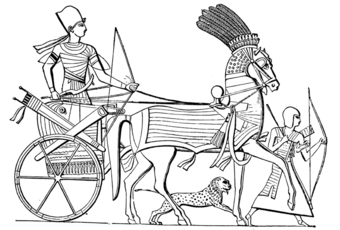Chariot: Difference between revisions
imported>Thomas Wright Sulcer (created) |
imported>Thomas Wright Sulcer (added picture) |
||
| Line 1: | Line 1: | ||
{{subpages}} | {{subpages}} | ||
[[Image:Egyptian-Chariot.png|thumb|right|340px|alt=Picture of a chariot (sketch).|An Egyptian chariot permitted a warrior to have high speed and hands-free access for spearing, clubbing, and permitting rapid retreat.]] | |||
A '''chariot''' was an [[invention]] from [[ancient]] [[Mesopotamia]] in which two or four [[wheel]]s were attached to an [[axle]] or axles and permitting a cart to be built on top; this structure was attached to a [[horse]] or horses by ropes or [[wood]]en bars. A [[human]] could ride in the cart and be pulled by the horses at a rate of [[speed]] much faster than walking. It was an important development in [[transportation]] and [[warfare]] and [[military technology]], since it permitted rapid attacks and movements, and a warrior would be higher up than a foot [[soldier]] and could attack using a [[bow and arrow]], [[spear]], [[mace]], [[club]], or other weapon. [[Archaelogy|Archaeologists]] and [[history|historians]] have evidence of chariots dating before 3000 BCE, although there is dispute whether the chariot was invented by the [[Hittites]], [[Mesopotamia]]ns, [[Ancient Egypt|Egyptians]], or others, and some sources suggest the earliest chariots were developed in an area north of [[Iran]] in modern [[Russia]]. A key invention permitting the chariot was when wheels had ''spokes'', making them lighter in [[weight]]. Chariots were also used in races, by messengers, by [[nobility]]. When horse [[breeding]] advanced to a point where larger horses could support mounted warriors, chariots became less valuable, and were replaced by [[cavalry]]. | A '''chariot''' was an [[invention]] from [[ancient]] [[Mesopotamia]] in which two or four [[wheel]]s were attached to an [[axle]] or axles and permitting a cart to be built on top; this structure was attached to a [[horse]] or horses by ropes or [[wood]]en bars. A [[human]] could ride in the cart and be pulled by the horses at a rate of [[speed]] much faster than walking. It was an important development in [[transportation]] and [[warfare]] and [[military technology]], since it permitted rapid attacks and movements, and a warrior would be higher up than a foot [[soldier]] and could attack using a [[bow and arrow]], [[spear]], [[mace]], [[club]], or other weapon. [[Archaelogy|Archaeologists]] and [[history|historians]] have evidence of chariots dating before 3000 BCE, although there is dispute whether the chariot was invented by the [[Hittites]], [[Mesopotamia]]ns, [[Ancient Egypt|Egyptians]], or others, and some sources suggest the earliest chariots were developed in an area north of [[Iran]] in modern [[Russia]]. A key invention permitting the chariot was when wheels had ''spokes'', making them lighter in [[weight]]. Chariots were also used in races, by messengers, by [[nobility]]. When horse [[breeding]] advanced to a point where larger horses could support mounted warriors, chariots became less valuable, and were replaced by [[cavalry]]. | ||
Revision as of 15:07, 18 April 2010
A chariot was an invention from ancient Mesopotamia in which two or four wheels were attached to an axle or axles and permitting a cart to be built on top; this structure was attached to a horse or horses by ropes or wooden bars. A human could ride in the cart and be pulled by the horses at a rate of speed much faster than walking. It was an important development in transportation and warfare and military technology, since it permitted rapid attacks and movements, and a warrior would be higher up than a foot soldier and could attack using a bow and arrow, spear, mace, club, or other weapon. Archaeologists and historians have evidence of chariots dating before 3000 BCE, although there is dispute whether the chariot was invented by the Hittites, Mesopotamians, Egyptians, or others, and some sources suggest the earliest chariots were developed in an area north of Iran in modern Russia. A key invention permitting the chariot was when wheels had spokes, making them lighter in weight. Chariots were also used in races, by messengers, by nobility. When horse breeding advanced to a point where larger horses could support mounted warriors, chariots became less valuable, and were replaced by cavalry.
In mythology
In Greek mythology, chariots were useful in warfare. In Roman poetry such as the Aeneid by Virgil, the goddess Juno, who loved Carthage, kept a war chariot there hoping that her beloved city-state would one day rule the Mediterranean world;[1] but this was not fated to happen, since Rome was founded (according to the epic poem) by the hero Aeneas.
References
- ↑ Virgil: Aeneid Book 1 Virgil's theme: a man dogged by the implacable hatred of an unforgiving goddess., the classics pages, 2010-04-18. Retrieved on 2010-04-18.
